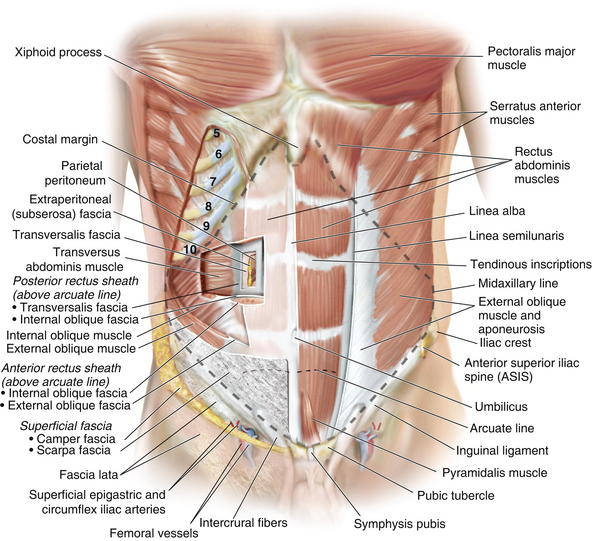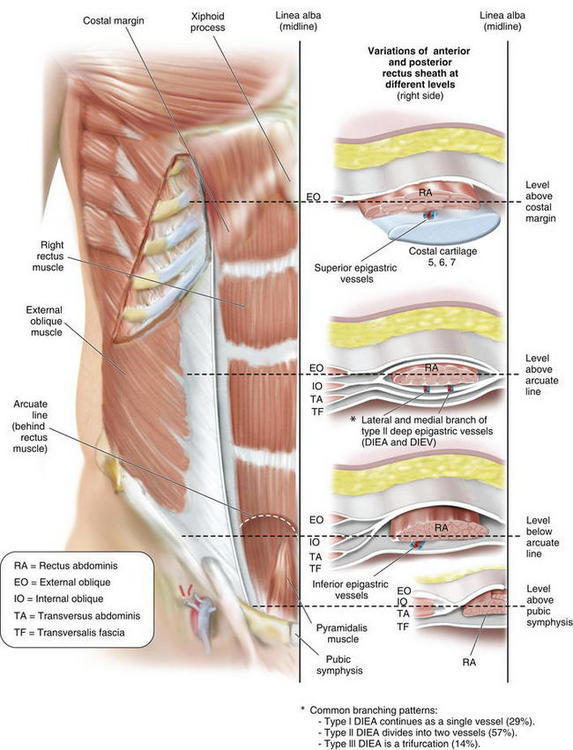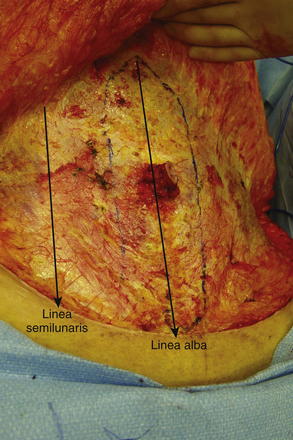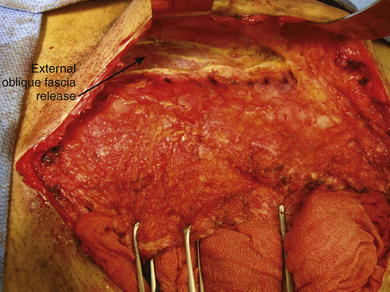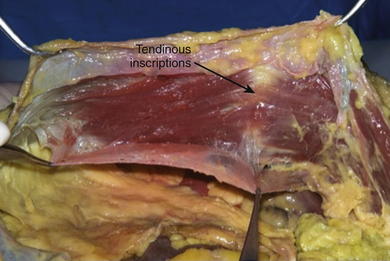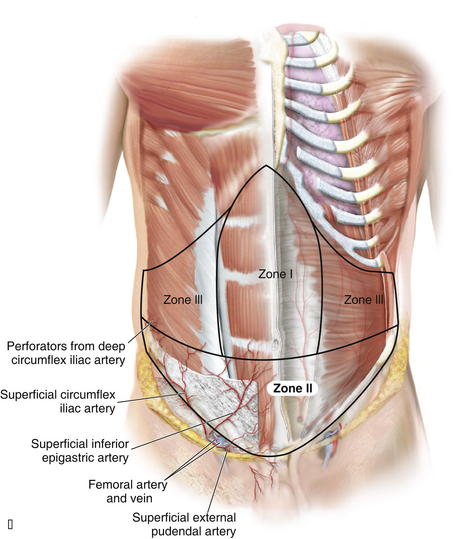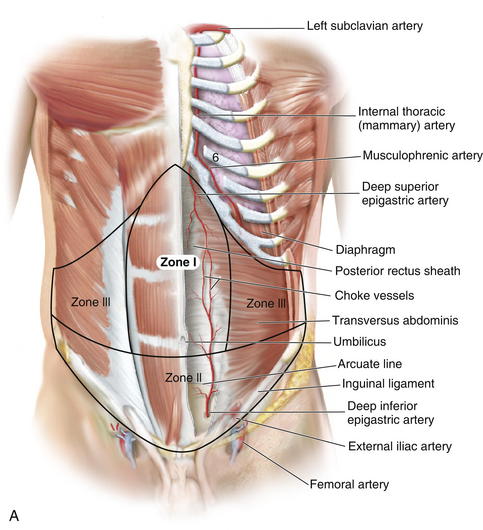Chapter 1 Abdominal Wall Anatomy and Vascular Supply
1 Clinical Anatomy
1 Overview
 The anterior abdominal wall (Figs. 1-1 to 1-3) is a hexagonal area defined superiorly by the costal margin and xiphoid process; laterally by the midaxillary line; and inferiorly by the symphysis pubis, pubic tubercle, inguinal ligament, anterior superior iliac spine, and iliac crest.
The anterior abdominal wall (Figs. 1-1 to 1-3) is a hexagonal area defined superiorly by the costal margin and xiphoid process; laterally by the midaxillary line; and inferiorly by the symphysis pubis, pubic tubercle, inguinal ligament, anterior superior iliac spine, and iliac crest. Layers of the anterior abdominal wall include skin, subcutaneous tissue, superficial fascia, deep fascia, muscle, extraperitoneal fascia, and peritoneum.
Layers of the anterior abdominal wall include skin, subcutaneous tissue, superficial fascia, deep fascia, muscle, extraperitoneal fascia, and peritoneum.2 Superficial Fascial Layers (see Figs. 1-1 and 1-2)
 The superficial fascia of the abdominal wall consists of a single layer above the umbilicus, consisting of the fused Camper and Scarpa fasciae.
The superficial fascia of the abdominal wall consists of a single layer above the umbilicus, consisting of the fused Camper and Scarpa fasciae. Below the umbilicus the superficial fascia consists of a fatty outer layer (Camper fascia) and a membranous inner layer (Scarpa fascia).
Below the umbilicus the superficial fascia consists of a fatty outer layer (Camper fascia) and a membranous inner layer (Scarpa fascia). Camper fascia is continuous inferiorly with the superficial thigh fascia and extends inferiorly to the scrotum in males and labia majora in females.
Camper fascia is continuous inferiorly with the superficial thigh fascia and extends inferiorly to the scrotum in males and labia majora in females. Scarpa fascia fuses inferiorly with the fascia lata of the thigh and continues posteriorly to the perineum, where it is called Colles fascia.
Scarpa fascia fuses inferiorly with the fascia lata of the thigh and continues posteriorly to the perineum, where it is called Colles fascia.3 Deep Fascial Layers (see Figs. 1-1 and 1-2)
 Laterally, layers of the abdominal wall deep to superficial fascia include external oblique, internal oblique, transversus abdominis, and parietal peritoneum.
Laterally, layers of the abdominal wall deep to superficial fascia include external oblique, internal oblique, transversus abdominis, and parietal peritoneum. The arcuate line (see Fig. 1-3) is located midway between the umbilicus and symphysis pubis and is a transition point where the posterior rectus sheath transitions from being the fusion of part of internal oblique fascia and transversalis fascia superiorly to only transversalis fascia inferiorly.
The arcuate line (see Fig. 1-3) is located midway between the umbilicus and symphysis pubis and is a transition point where the posterior rectus sheath transitions from being the fusion of part of internal oblique fascia and transversalis fascia superiorly to only transversalis fascia inferiorly. Above the arcuate line, the anterior rectus sheath consists of external oblique fascia and part of internal oblique fascia. The posterior rectus sheath consists of internal oblique fascia and transversalis fascia. The anterior and posterior layers of the rectus fascia therefore invest the rectus abdominis muscles.
Above the arcuate line, the anterior rectus sheath consists of external oblique fascia and part of internal oblique fascia. The posterior rectus sheath consists of internal oblique fascia and transversalis fascia. The anterior and posterior layers of the rectus fascia therefore invest the rectus abdominis muscles. Below the arcuate line, the external oblique and internal oblique fasciae merge to form the anterior rectus sheath. The posterior rectus sheath consists of transversus abdominis fascia, making this only a thin layer with minimal strength.
Below the arcuate line, the external oblique and internal oblique fasciae merge to form the anterior rectus sheath. The posterior rectus sheath consists of transversus abdominis fascia, making this only a thin layer with minimal strength. The linea alba results from fusion of the anterior and posterior rectus sheaths and lies in the midline, extending cranially from the xiphoid process to the pubic symphysis caudally Figure 1-4 shows the anterior wall fascia after dissection of the abdominal wall skin and subcutaneous tissue, showing the linea alba and linea semilunaris.
The linea alba results from fusion of the anterior and posterior rectus sheaths and lies in the midline, extending cranially from the xiphoid process to the pubic symphysis caudally Figure 1-4 shows the anterior wall fascia after dissection of the abdominal wall skin and subcutaneous tissue, showing the linea alba and linea semilunaris. Pearls and Pitfalls
Pearls and Pitfalls
Incision, release, and dissection of the anterior external oblique fascia can be done for repair of ventral hernias. This technique is called the components separation (Fig. 1-5). The incision in the external oblique fascia is made 1 to 2 cm lateral to the linea semilunaris, and the fascia is released to attain primary closure. Incisions also can be made in the posterior rectus sheath to gain additional length.
4 Abdominal Wall Musculature (see Figs. 1-1 to 1-3)
 The paired rectus abdominis muscles are the principal flexors of the anterior abdominal wall. They function to stabilize the pelvis while walking. They also protect the abdominal organs and help in forced expiration.
The paired rectus abdominis muscles are the principal flexors of the anterior abdominal wall. They function to stabilize the pelvis while walking. They also protect the abdominal organs and help in forced expiration. The rectus abdominis muscles originate from the pubic symphysis and pubic crest and insert on the anterior surfaces of the fifth, sixth, and seventh costal cartilages and the xiphoid processes. Laterally, the rectus sheath merges with the aponeurosis of the external oblique muscles to form the linea semilunaris (Fig. 1-4).
The rectus abdominis muscles originate from the pubic symphysis and pubic crest and insert on the anterior surfaces of the fifth, sixth, and seventh costal cartilages and the xiphoid processes. Laterally, the rectus sheath merges with the aponeurosis of the external oblique muscles to form the linea semilunaris (Fig. 1-4). Three to four tendinous inscriptions, which are adherent to the anterior rectus sheath, interrupt the rectus abdominis along its length (Fig. 1-6).
Three to four tendinous inscriptions, which are adherent to the anterior rectus sheath, interrupt the rectus abdominis along its length (Fig. 1-6). The external oblique muscle is the most superficial and thickest of the three lateral abdominal wall muscles. It originates from the lower eight ribs and courses in an inferomedial direction. Inferiorly it folds back on itself and forms the inguinal ligament, which extends between the anterior superior iliac spine and pubic tubercle. It is attached medially to the pubic crest.
The external oblique muscle is the most superficial and thickest of the three lateral abdominal wall muscles. It originates from the lower eight ribs and courses in an inferomedial direction. Inferiorly it folds back on itself and forms the inguinal ligament, which extends between the anterior superior iliac spine and pubic tubercle. It is attached medially to the pubic crest. The internal oblique muscle is deep to the external oblique muscle, and its aponeurosis splits medially above the arcuate line to form part of the anterior rectus sheath and part of the posterior rectus sheath. Below the arcuate line, the inferior oblique aponeurosis does not split and fuses with the external oblique fascia to form the anterior rectus sheath. The internal oblique muscle runs in a superomedial direction, perpendicular to the external oblique muscle. It originates from the thoracolumbar fascia, anterior two thirds of the iliac crest, and lateral half of the inguinal ligament. It inserts on the inferior and posterior borders of the tenth through twelfth ribs superiorly. Inferiorly, the internal oblique inserts on the pectineal line with fibers from the transversus abdominis, forming the conjoint tendon, which inserts on the pubic crest.
The internal oblique muscle is deep to the external oblique muscle, and its aponeurosis splits medially above the arcuate line to form part of the anterior rectus sheath and part of the posterior rectus sheath. Below the arcuate line, the inferior oblique aponeurosis does not split and fuses with the external oblique fascia to form the anterior rectus sheath. The internal oblique muscle runs in a superomedial direction, perpendicular to the external oblique muscle. It originates from the thoracolumbar fascia, anterior two thirds of the iliac crest, and lateral half of the inguinal ligament. It inserts on the inferior and posterior borders of the tenth through twelfth ribs superiorly. Inferiorly, the internal oblique inserts on the pectineal line with fibers from the transversus abdominis, forming the conjoint tendon, which inserts on the pubic crest. The transversus abdominis muscle is the deepest of the three lateral abdominal wall muscles and courses in a horizontal direction. It originates from the anterior three fourths of the iliac crest; lateral third of the inguinal ligament; and inner surface of the lower six costal cartilages, interdigitating with fibers of the diaphragm. The muscle ends medially in a broad flat aponeurosis, merging above the arcuate line with the posterior lamella of the internal oblique aponeurosis and the linea alba. Below the arcuate line, it inserts into the pubic crest and pectineal line, forming the conjoint tendon with the internal oblique.
The transversus abdominis muscle is the deepest of the three lateral abdominal wall muscles and courses in a horizontal direction. It originates from the anterior three fourths of the iliac crest; lateral third of the inguinal ligament; and inner surface of the lower six costal cartilages, interdigitating with fibers of the diaphragm. The muscle ends medially in a broad flat aponeurosis, merging above the arcuate line with the posterior lamella of the internal oblique aponeurosis and the linea alba. Below the arcuate line, it inserts into the pubic crest and pectineal line, forming the conjoint tendon with the internal oblique. The pyramidalis is a small triangular muscle found anterior to the inferior aspect of the rectus abdominis; it is absent in about 20% of the population. It originates from the body of the pubis and inserts into the linea alba inferior to the umbilicus.
The pyramidalis is a small triangular muscle found anterior to the inferior aspect of the rectus abdominis; it is absent in about 20% of the population. It originates from the body of the pubis and inserts into the linea alba inferior to the umbilicus. The semilunar lines are formed by fusion of the external oblique, internal oblique, and transversus abdominis aponeuroses at the lateral border of the rectus abdominis.
The semilunar lines are formed by fusion of the external oblique, internal oblique, and transversus abdominis aponeuroses at the lateral border of the rectus abdominis.5 Neurovascular Supply of the Abdominal Wall
 Pearls and Pitfalls
Pearls and Pitfalls
 Zone I consists of the upper and midcentral abdominal walls and is supplied by the vertically oriented deep superior (Fig. 1-7, A).and deep inferior epigastric arteries (Fig. 1-7, B).
Zone I consists of the upper and midcentral abdominal walls and is supplied by the vertically oriented deep superior (Fig. 1-7, A).and deep inferior epigastric arteries (Fig. 1-7, B). Zone II consists of the lower abdominal wall and is supplied by the epigastric arcade, superficial inferior epigastric, superficial external pudendal, and superficial circumflex iliac arteries. Perforators from the deep circumflex iliac arteries also supply a region of skin posterior and cephalad to the anterior superior iliac spine along the axis of the iliac crest.
Zone II consists of the lower abdominal wall and is supplied by the epigastric arcade, superficial inferior epigastric, superficial external pudendal, and superficial circumflex iliac arteries. Perforators from the deep circumflex iliac arteries also supply a region of skin posterior and cephalad to the anterior superior iliac spine along the axis of the iliac crest. Zone III consists of the lateral abdominal wall (flank region) and is supplied by the musculophrenic, lower intercostals (Fig. 1-8, A), and lumbar arteries (Fig. 1-8, B).
Zone III consists of the lateral abdominal wall (flank region) and is supplied by the musculophrenic, lower intercostals (Fig. 1-8, A), and lumbar arteries (Fig. 1-8, B).Stay updated, free articles. Join our Telegram channel

Full access? Get Clinical Tree


